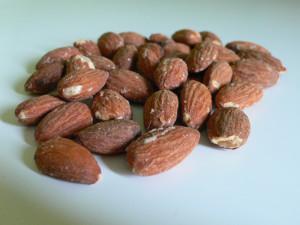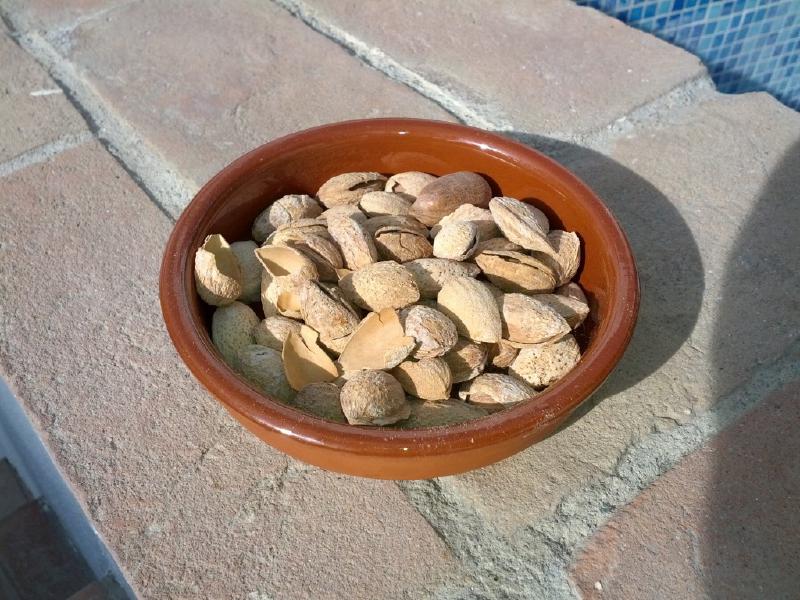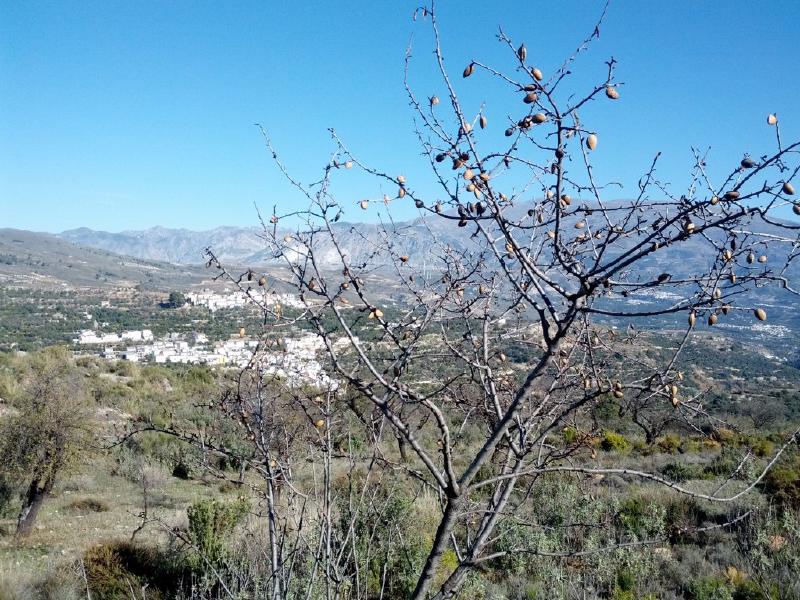Almonds reduce the risk on heart and cardiovascular diseases, they help lowering the cholesterol level, and almonds protect against diabetes.
There are bitter (wild) and sweet (domesticated) almonds. The bitter almonds contain cyanide in lethal quantities.

We usually eat the roasted sweet almonds. Sometimes we eat them fresh. Fresh almonds have a soft milky / creamy taste.
Almonds combine nicely with many ingredients. For example with: blackberries, chilli peppers, chicken, blueberries, coffee, pumpkin and rhubarb.
Roasting improves the taste of the nuts and makes them crunchy. During the roasting process, almonds lose some of their most valuable nutrients. It is better to eat them fresh instead of roasted. Fresh almonds can only be found right after the harvest season in the country or area of origin.

Almonds can be ‘roasted’ in 3 different ways: by frying them in animal fat, by frying them in vegetable oil or by heating them in an oven without adding fat. After frying with animal fat, a thin layer of the fat remains on the outside of the almonds. As animal fat becomes rancid rather quickly, the shelf life of roasted almonds is short.
We can roast almonds ourselves easily. Pre-heat the oven at 175 degrees Celcius / 347 degrees Fahrenheit. Put the shelled fresh almonds on a baking plate in the oven for 8 minutes. Stir after 4 minutes. They should be brown outside and inside.
You can also roast almonds while they are still in the shell. This is done in the south of Spain, in the Granada region. They are on offer everywhere. The results are shown in this picture:

The best way to store roasted almonds is dry, vacuum and in a cool place, preferably in the refrigirator. After about 1 month, the taste of roasted almonds deteriorates, so the best is to consume the them within 1 month after roasting.
Fresh and roasted almonds can also be deep frozen. That way they can be stored for a maximum of 2 years. But be careful when defrosting your almonds: take the almonds out of the bag or keep the bag open to get rid of the moisture as they might grow moldy.
Almond milk is a good (but no so cheap) and nice replacement for dairy milk. You can also prepare our oatmeal with almond milk, instead of with soy milk, cow milk or water.
Same people are allergic to almonds. If you get a metal taste in your mouth after eating almonds, you might be allergic to these nuts. Consult your doctor to find out.
According to wikipedia.org, almond trees originate from the middle east near the Meditarrenean area.

The almonds trees are among the first domesticated fruit trees. The wild species produce bitter nuts, that are not suitable for human consumption. Probably through coincidence, humans have successfully separated edible sweet versions of the almond tree and found them to be proper for consumption. They took the sweet versions and started to cultivate them in orchards.
Today, the bulk of the almonds are produced in the U.S.A. See the List of almond producing countries in the world below.
There are many different types of almonds. Among the highest quality types are Ferragnes and Texas, which are grown in Greece.
In the U.S.A., the almonds production is concentrated in California. The pollination of the almond trees there starts in February, typically at Valentines day (14th of the month). To do that, 50% of all the beehives in the U.S.A. are trucked to the Californian almond orchards. That’s a major event.
California counts over 800.000 acres of almond trees. For each acre 2 beehives with honey bees are needed for pollination. As we all know, the quantity of (honey) bees have been reduced in recent years. As we humans grow more and more crops each year, that require pollination by honey bees, the availability of bees is a limiting factor.
Conventional almond farms are sprayed with herbicides to keep away weeds, clover and other plants. Organic almond farms don’t. The plants and weeds covering the ground provide for a healthy habitat for bees and other pollinating insects. The droughts in California limit the water supply and put a lot of pressure on irrigation. The weeds, grass and plants on the ground of the organic farms hold a lot of water that is wasted on conventional farms. As a result, the organic farms use much less water.
Almonds Production
| Country | Tonnes | Percentage |
|---|---|---|
| United States of America | 1,814,372 | 61.3% |
| Australia | 160,000 | 5.4% |
| Spain | 149,000 | 5.0% |
| Morocco | 96,523 | 3.3% |
| Iran (Islamic Rep of) | 87,281 | 2.9% |
| Syrian Arab Republic | 83,230 | 2.8% |
| Turkey | 82,850 | 2.8% |
| Italy | 72,633 | 2.5% |
| Tunisia | 52,000 | 1.8% |
| China, mainland | 43,000 | 1.5% |
| China | 43,000 | 1.5% |
| Afghanistan | 42,215 | 1.4% |
| Algeria | 35,000 | 1.2% |
| Greece | 29,900 | 1.0% |
| Libya | 29,280 | 1.0% |
| Chile | 28,560 | 1.0% |
| Lebanon | 24,757 | 0.8% |
| Pakistan | 22,330 | 0.8% |
| Uzbekistan | 21,047 | 0.7% |
| Occupied Palestinian Territory | 9,062 | 0.3% |
| Israel | 8,984 | 0.3% |
| Portugal | 4,400 | 0.1% |
| Tajikistan | 3,421 | 0.1% |
| Jordan | 2,143 | 0.1% |
| Kyrgyzstan | 1,720 | 0.1% |
| Burkina Faso | 1,300 | 0.0% |
| Côte d’Ivoire | 1,500 | 0.1% |
| Georgia | 1,200 | 0.0% |
| Turkmenistan | 1,208 | 0.0% |
| Swaziland | 1,151 | 0.0% |
| United Arab Emirates | 1,092 | 0.0% |
| Bulgaria | 995 | 0.0% |
| Cyprus | 886 | 0.0% |
| The former Yugoslav Rep of Macedonia | 756 | 0.0% |
| Republic of Moldova | 700 | 0.0% |
| Azerbaijan | 651 | 0.0% |
| Argentina | 648 | 0.0% |
| France | 642 | 0.0% |
| Iraq | 536 | 0.0% |
| Croatia | 211 | 0.0% |
| Gambia | 196 | 0.0% |
| Yemen | 165 | 0.0% |
| Kazakhstan | 120 | 0.0% |
| Hungary | 100 | 0.0% |
| Mexico | 60 | 0.0% |
| Bosnia and Herzegovina | 49 | 0.0% |
| Nepal | 10 | 0.0% |
| Ukraine | 10 | 0.0% |
| Total: | 2,960,894 |
Recipes with Almonds: 1. Salad
Preparation time: appr. 30 minutes
